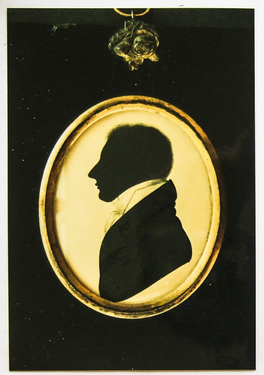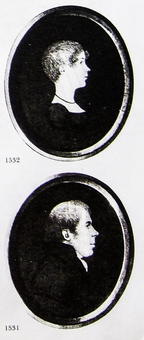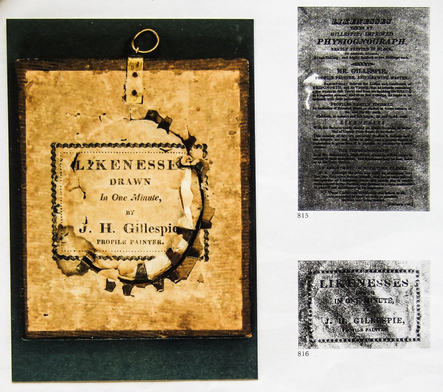Gillespie, J. H. (SCC Newsletter September 2004)
J.H. Gillespie fl.1810-1838 A NEAT AND COMPETENT ARTIST AND BOTH SILHOUETTIST & MINIATURIST.
Unfortunately little is known about Mr. Gillespie's background or his working life. This is largely due to the fact that he was an itinerent artist without a known permanent address. This makes research almost impossible. His trade labels are short with no address and undated. Only one english handbill is recorded - this was used in Bridgenorth. It's wording does give some idea of his modus operandi, when he was travelling about the country. There is some 'evidence' that he was working in England between 1810-20. Also it is recorded that he visited the United States and Canada - he was in Nova Scotia and Halifax in 1829, Baltimore in 1837 and Philadelphia in 1839. He visited New York during these years as well. It is not clear whether he returned to England after 1839 and continued to paint or where he was from 1820-1829. Whilst working in England he visited a number of ‘centres' including London, Edinburgh, Liverpool, Manchester, Bridgenorth and probably others. From the Bridgenorth handbill it is known that he used local shops and post offices to display samples of his work and house his Physiogrotrace. No doubt he stayed in digs, where he had space to complete the finishing touches. In addition to silhouettes he also painted profile miniatures and copper-plate bust profiles. Any further research to 'discover' more details of his personal and family background I think would be difficult without some essential basic facts. It was suggested by an article in "Antique" June, 1930 (a U.S. magazine published to this day) that he might have died abroad. I have a 'picture' of him as a quietly organised man, who did not seek showy publicity - only making modest claims for his art unlike some of his contemporaries!
References. My main reference is of course Mrs. McKechnie's Book - she has two entries on Mr. Gillespie. The main entry is in section 2 (pages 408-409) and the other in section 6 (page 710), which looks at the copper-plate busts. She illustrates six examples of his works as well as two labels and the Bridgenorth handbill. Mrs. N. Jackson has a short entry in her Dictionary on page 109 - in this she states that he was probably working as early as 1793 and cut as well as painted silhouettes. Mrs. McKechnie did not agree with either assertion! Arthur Mayne in his "British Profile Miniaturists" on page 112 also states that Mr. Gillespie was a "cutter", but he was not always to be relied upon! Daphne Foskett lists Mr. Gillespie in her "Miniatures, Dictionary & Guide". She dates his working career from 1820-1838 - she makes no comment on his work and has no illustrations. The U.S. magazine "Antiques" has two references to Mr. Gillespie - February, 1928 and June, 1930. I have been unable to obtain a copy of the earlier article.
His work in general. Mr. Gillespie does not hide the fact that he used his Physiogrotrace to obtain his outlines - he then used his brushwork skills to put his individual 'stamp' on the work. These skills are described as neat by Mrs. McKechnie and of a standard for him to paint profile miniatures of some quality on ivory. However, most of his recorded works are painted in a dark grey base colour with clothing detail added in a black pigment mixed with gum arabic. Also, he painted in other base colours i.e. black and brown. On both these base colours he used gold for highlights. Examples are rare and are not considered to be as skillfully painted as those on a dark grey base (see p.482 illus. 814 in Mrs. Mck.) I have seen gold highlights on a man with a brown base colour on one occasion - I noted that the effect was not particularity pleasing and that the gilding was somewhat cursory. Mr. Gillespie's most distinctive 'trade mark' is a group of fanning strokes with which he separates the sitter's arm from the rest of the body. This tends to be more obvious on his silhouettes of men and provides a good aid to attribution in the absence of a label. It is sometimes less obvious on his women, where he may make the bust-line termination somewhat flatter.
GILLESPIE CONT’D.


Eyelashes are painted in one medium length stroke and when eyebrows are shown these are painted with a small swirl of fine strokes. Hair outside the main body is neatly and finely painted. He paints on card, which is sometimes quite thick. His bust-length silhouettes are about 2½ " in height. The frames he used were standard papier mache of the period - not of particularily good quality with emblem hangers.
His men/gents. I have illustrated above a photograph of a labelled man and two other photocopies of men from Mrs. McKechnie's Book - both are illustrated on page 482 (illus. 812 of Thomas Town & illus. 811 of an unknown man). Unfortunately it is difficult in the photograph to see all the clothing detail but I think you can see enough! All three works are painted in a dark grey base colour, which at times can look almost black. Mr. Gillespie was a consistent and tidy painter and identification of his works can be aided by noting his 'regular' characteristics particularily when painting men. Firstly he used a deep line of gum arabic at the 'M' notch on the jacket rever plus deepish line of gum arabic beneath the collar itself. Secondly he always shows the corrugations of the jacket at the back of the neck. Thirdly he paints shirts and stocks in a thinned pigment without gum arabic. Finally he painted hair as a grey mess of swirling brush strokes with no gum arabic. Hair outside the main body was carefully painted. Other artists used similar 'touches' but it is the combination and Gillespie's overall style that makes the attribution.
GILLESPIE CONT’D

His women/ladies. On the page I have photographed a lady from a collection. On the left she is a little smaller than life-size in order to show her full frame. On the right she has been greatly enlarged to show all her clothing detail and Gillespie's style with this. She represents a typical example of his work on a dark grey base - unfortunately she has long since parted company with her trade label! Note the fanning strokes at the demarcation of her arm. Her neck frill is particularily well shown. She has an eyelash, but this is difficult to see.
Before looking at some other ladies on the next page it seems an opportunity to mention Gillespie's work in the U.S.A. It seems that until the short article was printed in "Antiques" in June , 1930 no works by Gillespie had been traced in the U.S.A. inspite of the fact that he had visited the States on several occasions between 1829 & 1839. However, three works by him were illustrated in the article (two of the copper-plate bust variety and one with a brown base colour) - all formed part of the collection of the Rev. Glen Tilley Morse a well-known collector at the time and had been painted in the States. It seems works by Gillespie had been seen but these were painted in England. In this connection the article further suggests that Gillespie does not appear to have shared in the "American sucess" as had Hubard & Edouart. However, Gillespie was not a child prodigy like Hubard or a consummate publicist like Edouart! Finally the article goes on to speculate on Gillespie's demise I quote "was he so suddenly overcome with homesickness that he packed his belongings & returned to his native land without leaving a single souvenir behind or was he seized with a sudden distemper which conveyed him untimely to a still more distant shore"!!
GILLESPIE CONT’D

Now to continue with the ladies! On this page I have photographed another unlabelled lady . She is Mrs. Holsworth c.1819 of Cambridge - perhaps Gillespie also visited that city. There has been some minor deterioration in her paint quality, which has made it more difficult to show her clothing detail. Therefore I have added to her right a photocopy of her life size in the hope that this would be clearer, but I fear it is not. In her frame she looks as if she is without any detail, but tilted into the light all is revealed! This is one of the problems when the colour of the highlights is only a little darker than the base colour - unlike gilding. Also I have photocoped a comfortable looking lady from Mrs. McKechnie on page 482 illus. 813. As you will have observed from these two ladies their bust-line terminations are not the same. Mrs. McKechnie records one labelled example of a man, where the sitter's waistcoat protrudes well beyond the line of the profile in front this was painted in a thinned pigment and Mrs. McKechnie felt that it gave a very finished and professional look. There was a man for sale at Bonhams on 19th February, 1998 where Gillespie had made a 'nick' as well as painting fanning strokes at the arm demarcation. Clearly he liked some variation inspite of his consistency in other ways. Gillespie painted children, but I have no evidence that he painted full-length figures.
GILLESPIE CONT’D

 Copper-plate bust profiles. On this page I have photographed two further examples – neither are labelled but both are clearly by Gillespie. Again the fanning strokes can be seen again at the arm. I have also photocopied two similar examples of the Hartley Family from Mrs. McKechnie’s Book – both are illustrated on page 727 & 728 illus. 1531 for James and illus. 1532 for Harriet. A lot of gum Arabic has been applied in all four with good effect. I think Gillespie excels at these portraits. Mrs. McKechnie regarded these of high quality with features carefully painted. Faces are generally a dull brown colour with a grey wash. There is a thick line of gum arabic under the bust-line termination, which enhances the copper plate impression and the black background. Also Gillespie painted profile miniatures in watercolours, but I have not seen any examples. He seems to have promoted these miniatures stating that he used a method that was entirely new, colours would not fade and a greater degree of expression was obtained than a mere outline. So much for the ‘value’ of silhouettes!
Copper-plate bust profiles. On this page I have photographed two further examples – neither are labelled but both are clearly by Gillespie. Again the fanning strokes can be seen again at the arm. I have also photocopied two similar examples of the Hartley Family from Mrs. McKechnie’s Book – both are illustrated on page 727 & 728 illus. 1531 for James and illus. 1532 for Harriet. A lot of gum Arabic has been applied in all four with good effect. I think Gillespie excels at these portraits. Mrs. McKechnie regarded these of high quality with features carefully painted. Faces are generally a dull brown colour with a grey wash. There is a thick line of gum arabic under the bust-line termination, which enhances the copper plate impression and the black background. Also Gillespie painted profile miniatures in watercolours, but I have not seen any examples. He seems to have promoted these miniatures stating that he used a method that was entirely new, colours would not fade and a greater degree of expression was obtained than a mere outline. So much for the ‘value’ of silhouettes!
Handbills. Two have been recorded – the Bridgenorth Handbill and the Philadelphia Handbill 1838. I have not seen the latter, although it was mentioned in the “Antique” magazine article in February 1828.
GILLESPIE CONT’D

The Bridgenorth Handbill is photcopied above (p. 483 in Mrs. McK.) It is possible with a magnifying glass to read the full text in the Book. It gives some useful information about Gillespie's prices - ls. for black profiles, 2s. for highly finished, bronzed & shaded in watercolours 5s. & 7s. 6d. Children full-length were 5s. & 7s.6d. Copper-plate busts were 5s.
Labels. Two have been recorded and illustrated in Mrs. McKechnie's Book. I have photographed no. 1 on the left above and photocopied no. 2 on the right. These only vary in the type-set and the decoration around the wording - both are small 24" X 2". Recently a third label has come to light from a sale at Bonhams on 19th. February, 1998. Unfortunately I only have a poor copy of this label but interestingly it was orange in colour and would appear to be later than nos. 1 & 2. On it he adds "Improved Physiogrotrace" and gives a price of 2s. 6d. It was backing a silhouette painted in a black base colour with gold highlights. The increased price suggests a later label.
To sum up Mr. Gillespie was a neat and competent artist, whose works whilst not 'exciting' were well painted conveying something of the sitters' personalities. I think he was probably at his best when painting his copper-plate bust profiles.







